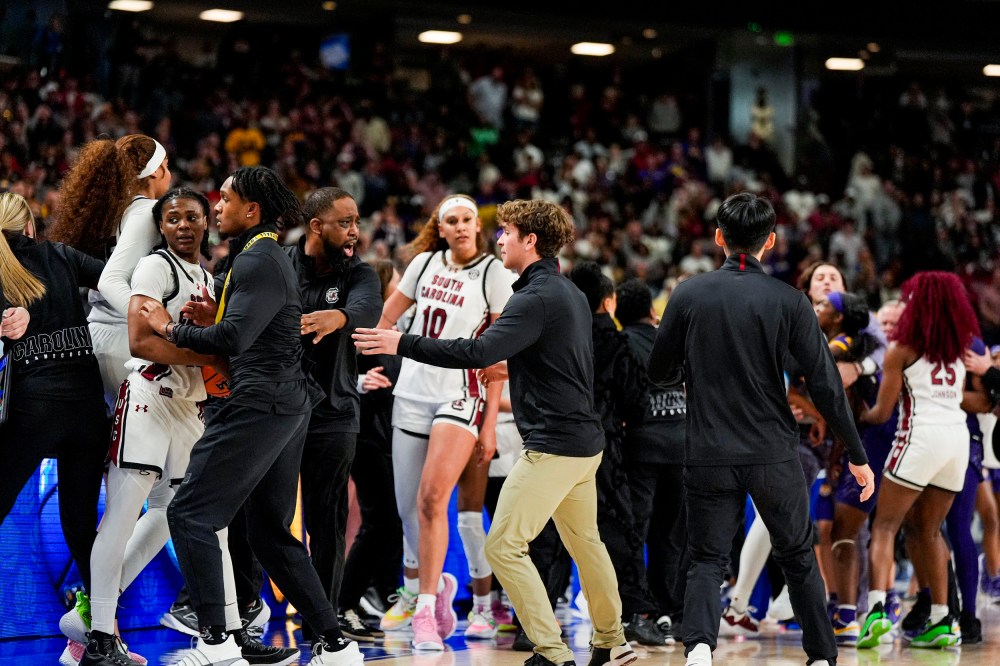In a scuffle near the end of Sunday’s Southeastern Conference women’s basketball championship in Greenville, South Carolina, Kamilla Cardoso, South Carolina’s 6-foot-7-inch center, pushed down Flau’jae Johnson, LSU’s 5-foot-10-inch guard. That prompted 24-year-old Trayron Milton, Johnson’s brother, to jump over the scorer’s table and onto the court, where he briefly made contact with Cardoso.
Milton seemed to size up the much taller Cardoso, realize he had made a terrible mistake and backed off. But what if he hadn’t?
Milton seemed to size up the much taller Cardoso, realize he had made a terrible mistake and backed off. But what if he hadn’t? Officials say Milton pushed down an SEC employee and stepped on that person’s shoulders to make it to the court. Greenville police booked Milton with assault and battery and disorderly conduct, two misdemeanors. He was released from jail Monday after posting bail. Police say two other people made it out of the stands and to the scorer’s table, but were prevented from running onto the floor.
It may sound alarmist, but it would also be naïve for us to not think about former tennis great Monica Seles, whose career was derailed in 1993 when a fan in Hamburg, Germany stabbed her in the back as she set in the changeover chair between games. When someone who shouldn’t be there runs onto a court, there’s no way of knowing who has ill intentions.
The same goes for jubilant fans who storm the court after a big, sometimes unexpected, victory. Both situations put players at risk.
Jon Scheyer: “When are we going to ban court-storming? … It’s a dangerous thing.”
— Josh Graham (@JoshGrahamShow) February 24, 2024
Scheyer says Kyle Filipowski sprained his ankle during the Wake Forest court-storm. pic.twitter.com/zE1yr7O6bJ
This season alone, we have seen fans rushing the court result in a near injury for Iowa’s Caitlin Clark — the most watched and most valuable player in all of college basketball — and in a knee injury for Duke center Kyle Filipowski, after Wake Forest fans stormed the court following their upset victory over the Blue Devils. But that’s child’s play compared to what could happen: a severe injury, an assault or an accident that ends someone’s season. While court storming is often dismissed as happy-go-lucky hijinks or kids being kids, when 15,000 people rush a 94-by-50-foot court, something bad happening is inevitable.
Though this season has provided new reasons for us to be concerned about security and player safety, there are stories of fans storming the court that date back over 60 years. But the phenomenon, now fueled by social media as fans want their antics up on Instagram as soon as possible, has become de rigueur — almost a rite of passage — in a way it never has before.
This season alone, we have seen fans rushing the court result in a near injury for Iowa’s Caitlin Clark — the most watched, most valuable player in all of college basketball — and in a knee injury for Duke center Kyle Filipowski.
Court storming is supposed to happen after the home team either upsets a higher-ranked opponent or defeats a rival. But with so much parity in men’s and women’s college hoops, such upsets are far more frequent. Fans therefore show up not only hoping against hope that their team will win but also already ready to storm the court if they do.
The dangers of court storming have some leading voices in college hoops proposing radical, even carceral, solutions: ESPN’s Jay Bilas, one of the most influential voices in these spaces, said on one of that network’s shows last month that he wants court stormers to receive citations or be subject to arrest. “Just say, ‘You’re all detained,’ and give them all citations, or arrest them if you want to. And then court stormings will stop the next day.”
The problem with this idea is that the sheer tonnage of law enforcement it would take to accomplish this would turn every college stadium into an internment camp of arrests and detention. More police and surveillance seem to be our solution for everything in the United States. Just ask people on the New York City subways.

Take former New York Police Department Chief Terence “Terry” Monahan, who helped craft the anti-storming policies at Yankee Stadium. Stopping it would be “very easy,” he told NBC News. “You make an announcement, ‘Hey you’re subject to an arrest, and if you’re student, you could be suspended.’ All of a sudden, there’s a consequence going on to the floor. As of now, there is no consequence — no one is saying you can’t do it.”












